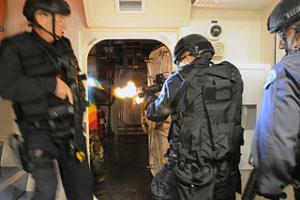Mass shootingsImproving police responses to mass shootings
Before Columbine, law enforcement acted on the assumption that mass casualty incidents would involve a barricaded lone shooter who could be isolated, or a hostage situation in which the attackers would engage in negotiation before they killed more people. Thus, protocols established after the 1966 sniper attack at the University of Texas, called for first responders in the United States to set up a perimeter around the site of the shooting, gather as much information as possible, and then wait for specially trained assault teams, hostage negotiators, medics, and other specialists to arrive. “The assumption,” one expert said, “was that time was on their side.” Police forces arriving on the scene of a shooting no longer entertain this assumption.

L.A.P.D. SWAT team training aboard an U.S.Navy vessel // Source: commons.wikimedia.org
Mass shootings carried out by terrorists and lone gunmen have a destabilizing effect because of the large number of casualties. Police forces, learning from past experiences with mass shooting, are fine-tuning their tactical responses in order to minimize the number of dead and injured by tackling the gunmen as soon as possible. The key insight law enforcement agencies derived from the Columbine High School killings in Colorado in 1999, is that first responders should not merely surround the site where the incident is taking place and wait around for specialized assault teams to arrive. Rather, first responders and police forces first to arrive on the scene should go in right away to confront the attacker or attackers before more people can be harmed. The first responders should go in as quickly as possible even if the risk to their lives is heightened by the fact that they may not have the kind of training and gear SWAT units have.
PoliceOne.com notes that security and law enforcement experts have concluded that the increased risks these first responders assume outweighed by the knowledge that killers determined to inflict as many deaths as possible and create maximum carnage will not stop shooting and killing until they are neutralized.
Training manuals used by first responders in the United States and other countries now teach that units first to arrive on the scene should form teams of four officers each and, in a diamond formation, go into the site where the shooting is taking place with the sole objective of killing or disarming the attackers. A secondary team, which includes medical staff and more police for cover, should follow close behind to take care of the wounded even if the scene has not yet been secured.
The Guardian reports that the basic protocol has been fine-tuned over the past ten years to take into account multiple shooters, suicide vests, and other dangers not imagined in the past. The protocol requires first responders to be focused on the mission and avoid distractions, and not only because they will face the reality of being shot at by the attackers, but because they are likely to confront harrowing situations. To pursue and neutralize the attackers, first responders might have to step over dead bodies and ignore pleas for help from the wounded.
“You’re going to have to walk over dead people,” an LA police officer, who asked not be named because he had not been cleared to speak to the media, told the Guardian. “You’re going to have people clutching at you and begging for help. But you have to keep going. There’s no medicine in a gunfight.”
The new approach to dealing with mass shooting can still be improved, and kinks need to be ironed out. For example, the French police’s approach to the developing situation inside the Bataclan concert hall appears to have been based on the mistaken impression that what was underway was a hostage situation. This explains the two-and-half hour delay between the time the police arrived on the scene and the decision to storm the building – time which allowed the terrorists to kill many more people than otherwise would have been the case.
John Cohen, a former top coordinator for counterterrorism at DHS who is now at Rutgers University, told Guardian, that, “I’m confident the French authorities will conduct an after-action review and will specifically seek to better understand whether they could have handled the situation at the theater differently — whether they should have sought to enter and confront the suspects earlier. There’s still a learning process — in this country, too. There are conversations going on at all levels in the United States, Europe and elsewhere.”
Before Columbine, law enforcement acted on the assumption that mass casualty incidents would involve a barricaded lone shooter who could be isolated, or a hostage situation in which the attackers would engage in negotiation before they killed more people. Thus, protocols established after the 1966 sniper attack at the University of Texas, called for first responders in the United States to set up a perimeter around the site of the shooting, gather as much information as possible, and then wait for specially trained assault teams, hostage negotiators, medics, and other specialists to arrive.
“The assumption,” Cohen said, “was that time was on their side.”
Police forces arriving on the scene of a shooting no longer entertain this assumption.
